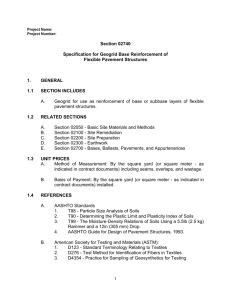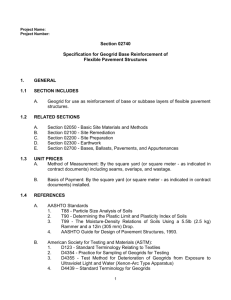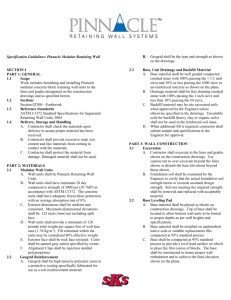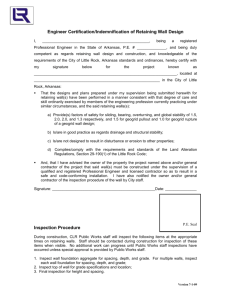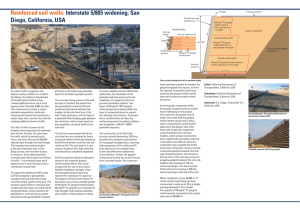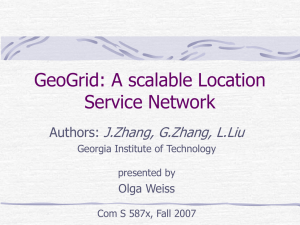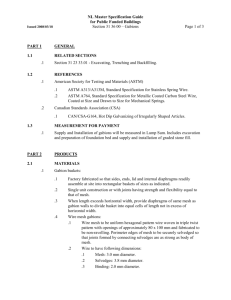Revised 32 32 34 MRE Wall System Final
advertisement
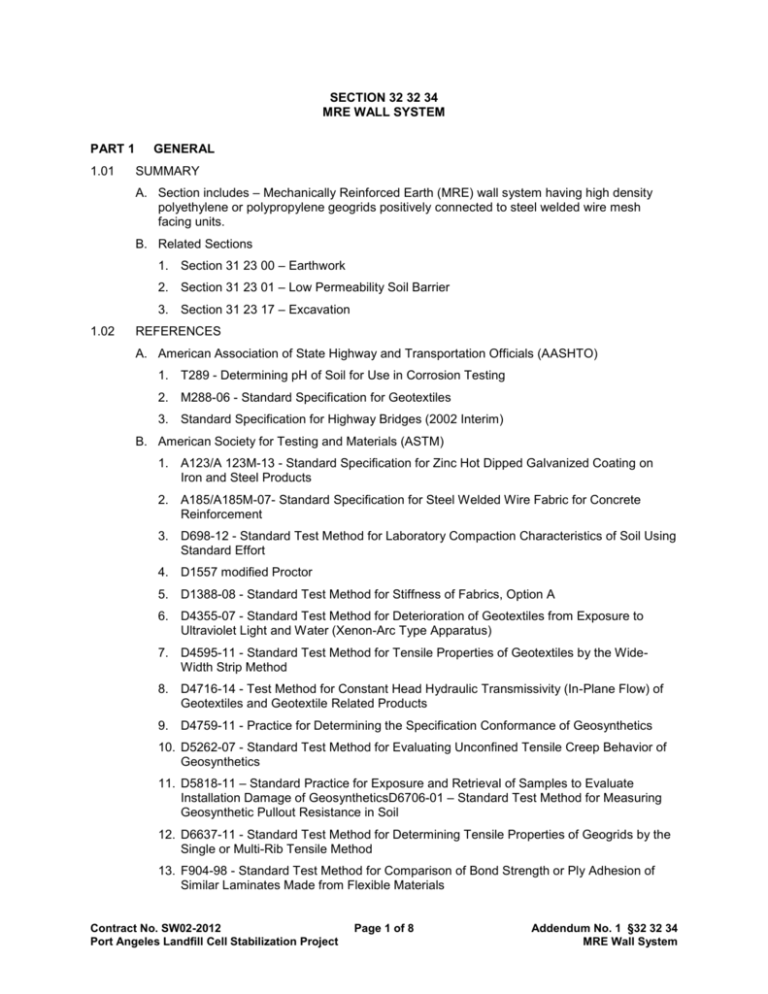
SECTION 32 32 34 MRE WALL SYSTEM PART 1 1.01 GENERAL SUMMARY A. Section includes – Mechanically Reinforced Earth (MRE) wall system having high density polyethylene or polypropylene geogrids positively connected to steel welded wire mesh facing units. B. Related Sections 1. Section 31 23 00 – Earthwork 2. Section 31 23 01 – Low Permeability Soil Barrier 3. Section 31 23 17 – Excavation 1.02 REFERENCES A. American Association of State Highway and Transportation Officials (AASHTO) 1. T289 - Determining pH of Soil for Use in Corrosion Testing 2. M288-06 - Standard Specification for Geotextiles 3. Standard Specification for Highway Bridges (2002 Interim) B. American Society for Testing and Materials (ASTM) 1. A123/A 123M-13 - Standard Specification for Zinc Hot Dipped Galvanized Coating on Iron and Steel Products 2. A185/A185M-07- Standard Specification for Steel Welded Wire Fabric for Concrete Reinforcement 3. D698-12 - Standard Test Method for Laboratory Compaction Characteristics of Soil Using Standard Effort 4. D1557 modified Proctor 5. D1388-08 - Standard Test Method for Stiffness of Fabrics, Option A 6. D4355-07 - Standard Test Method for Deterioration of Geotextiles from Exposure to Ultraviolet Light and Water (Xenon-Arc Type Apparatus) 7. D4595-11 - Standard Test Method for Tensile Properties of Geotextiles by the WideWidth Strip Method 8. D4716-14 - Test Method for Constant Head Hydraulic Transmissivity (In-Plane Flow) of Geotextiles and Geotextile Related Products 9. D4759-11 - Practice for Determining the Specification Conformance of Geosynthetics 10. D5262-07 - Standard Test Method for Evaluating Unconfined Tensile Creep Behavior of Geosynthetics 11. D5818-11 – Standard Practice for Exposure and Retrieval of Samples to Evaluate Installation Damage of GeosyntheticsD6706-01 – Standard Test Method for Measuring Geosynthetic Pullout Resistance in Soil 12. D6637-11 - Standard Test Method for Determining Tensile Properties of Geogrids by the Single or Multi-Rib Tensile Method 13. F904-98 - Standard Test Method for Comparison of Bond Strength or Ply Adhesion of Similar Laminates Made from Flexible Materials Contract No. SW02-2012 Port Angeles Landfill Cell Stabilization Project Page 1 of 8 Addendum No. 1 §32 32 34 MRE Wall System 14. Geosynthetic Research Institute (GRI) a. GG1-87 - Standard Test Method for Geogrid Rib Tensile Strength b. GG2-87 - Standard Test Method for Geogrid Junction Strength c. GG5-91 - Standard Method for Geogrid Pullout 15. Tensar International Corporation (TIC) a. “Design Guidelines for Tensar Geogrid Reinforced Soil Walls with SierraScape® Facing Units,” TTN:SierraScape-DG. 1.03 DEFINITIONS A. Ultimate Tensile Strength - Breaking tensile strength when tested in accordance ASTM D6637-01 B. Junction Strength - Breaking tensile strength of junctions when tested in accordance with GRI-GG2 as modified by AASHTO Standard Specification for Highway Bridges, 2002 Interim, using a single rib having the greater of 3 junctions or 8 inches and tested at a strain rate of 10 percent per minute based on this gauge length. Values shown are minimum average roll values. C. Structural Geogrids – An HDPE polymeric grid formed by a regular network of integrally connected tensile elements with apertures of sufficient size to allow interlocking with surrounding soil, rock or earth and function primarily as reinforcement. D. Welded Wire Facing Units – A 9.1 foot long by 3 to 3.5 foot wide steel welded wire mesh sheet that is bent 90 degrees at its long center line to form an “L” shaped unit. The vertical 18 inch high section provides a face that retains the fill. The horizontal 1.5 to 2 foot leg extends into the fill. Diagonal wire struts connect the top horizontal wire on the face to the parallel wire at the rear edge to increase the stiffness of the face and increase lateral support of the stone face fill. They are placed at the ends and at about 16 inch spacing along the facing unit. E. Mechanical Connection - The horizontal leg of the welded wire facing units have an inverted “U” shaped “loop” bent into the transverse wires near its rear edge. The loops fit up through the apertures of the geogrid and bear against the cross machine bars of the geogrid. This forms a structural connection that transfers load between the facing unit and the geogrid. F. Locking Tail Strut – A 24” long, electroplated 0.24” diameter wire with a hook at one end and a 5” long, “locking tail” bent perpendicular to the primary length on the other end. The hook is fastened to the top of the welded wire face unit and the locking tail is placed through 3 inverted “U”s to lock the geogrid reinforcement in place until backfill is placed. G. Topsoil – Topsoil placed immediately behind the vertical wires of the Facing Units. Topsoil shall conform to topsoil in Earthwork specification and be suitable for vegetation. H. Structural Fill- Compacted structural fill placed within the geogrid reinforced volume. 1.04 I. Long-Term Design Strength (LTDS or Tal) - The maximum allowable stress level of the polymeric grid used in the internal stability design calculations of the retaining buttress. Ultimate Tensile Strength reduced by the effects of creep, installation damage and durability. J. Long-Term Allowable Design Strength (Ta) - The Long-Term Design Strength (LTDS or Tal) reduced by the Factor of Safety for design uncertainties (Ta = Tal/FSUNC). SUBMITTALS A. Product Data - Manufacturer's materials specifications, installation instructions, and general recommendations. B. Design Data – Design calculations for the reinforced earth buttress system sealed by a Registered Professional Engineer. Contract No. SW02-2012 Port Angeles Landfill Cell Stabilization Project Page 2 of 8 Addendum No. 1 §32 32 34 MRE Wall System C. Construction Plans – Detailed Construction plans for the reinforced buttress system sealed by a Registered Professional Engineer. D. Samples 1. Geogrid - 4-in. by 16-in. piece 2. Geotextile Materials - 4-in by 8-in pieces E. Quality Control Submittals 1. Certificates - Manufacturer's certification that the Ultimate Tensile Strength and the Junction Strength of the geogrid are equal to or greater than those specified by the system designer. 1.05 QUALITY ASSURANCE A. The HDPE geogrid shall be provided by one of vendors identified on WSDOT’s Qualified Product List (QPL). B. If Contractor proposes alternate product than specified the Contract must contract a Designer - A Professional Engineer, registered in the State of Washington, who is employed by a firm that has designed at least 500,000 square feet of MRE buttresses, and who can provide a certificate of Errors and Omissions insurance to the Engineer and/or Architect with a minimum value of $3,000,000 per occurrence and in the aggregate. C. Mock-Ups 1. Prior to construction of the MRE buttress, erect a sample section of buttress using materials shown and specified. Build mock-up at the site, where directed, approximately 20 feet long by 4.5 feet high. System Supplier shall provide qualified representative onsite for mock-up buttress to provide installation guidance of the system. 2. Do not start final construction until the Architect and/or Engineer approves the mock-up. Retain mock-up during construction as a standard for judging completed work. Do not alter or destroy mock-up until work is completed. D. Pre-Construction Conference - Prior to erection of MRE buttress, hold a meeting at the site with the MRE buttress materials supplier, the MRE buttress installer, and the Designer to review the MRE buttress requirements. Notify the Owner, the Engineer and/or Architect at least 3 days in advance of the time of the meeting. 1.06 DELIVERY, STORAGE, AND HANDLING A. Storage and Protection 1. General a. Prevent excessive mud, wet concrete, epoxy, or other deleterious materials from coming in contact with and affixing to retaining buttress materials. 2. Polymeric Materials a. Store at temperatures above -20 degrees F (-29 degrees C). b. Rolled materials may be laid flat or stood on end. PART 2 2.01 PRODUCTS MANUFACTURERS A. The SierraScape Retaining Slope System as designed and manufactured by The Tensar International Corporation, Atlanta, GA. B. Alternate MRE buttress systems will be considered with similar aesthetic and proven track record. All substitutions must be submitted to owner 2 weeks or 10 business days prior to bid Contract No. SW02-2012 Port Angeles Landfill Cell Stabilization Project Page 3 of 8 Addendum No. 1 §32 32 34 MRE Wall System for approval. Bidding contractor should not bid alternate system without approval. No alternate systems will be approved after the bid. Alternate geogrid reinforcement shall be identified on WSDOT’s Qualified Product List (QPL) and follow the reduction factors identified in 2.02. 2.02 MATERIALS A. Structural Geogrid - The required physical and mechanical properties of geogrid reinforcement shall be determined in accordance with the following performance requirements. 1. Primary Geogrid - The primary geogrid’s long-term design strength (LTDs) shall be a minimum of 3,620 pounds per foot, and shall be determined in accordance with the following: Where: LTDS = TULT RFCR x RFID x RFD a. TULT - Ultimate Tensile Strength shall be the minimum average roll value ultimate tensile strength as tested per ASTM D6637. This test shall be conducted without artificially deforming test materials under load before measuring such resistance or employing an artificial “secant” or “offset” tangent basis of measurement so as to overstate tensile properties. b. RFCR – The Reduction Factor for Creep is the ratio of TULT divided by the creep rupture strength determined in accordance with ASTM D5262 Long-term creep rupture of the reinforcement shall be determined from controlled laboratory testing conducted for a range of load levels and durations in accordance to ASTM D5262 adequate for extrapolation to the design life. Elevated temperature can be used to accelerate creep rupture test for the purpose of extrapolation. A minimum total of 12 rupture data points with a minimum of 4 data points at each temperature and at least one test having a rupture time over 10,000 hours or more are required to establish a rupture envelope. The requirement for the minimum creep test may be waived for a new product if it can be demonstrated that is sufficiently similar to a proven creep tested product of a similar nature. When these conditions are met, creep testing shall be conducted for at least 1,000 hours before time shifting, with adequate elevated temperature data to permit to 50,000 hours or more. The limited test results of the new product are compared to the results of the previously conducted full testing program. The 1,000 hour creep curves must pattern very closely to the 1,000 hour porting of the similar product to demonstrate equivalency. Creep testing is required on representative samples of the finished product and not a single component of the geogrid (e.g., fiber and/or yarn). The ultimate strength used in this calculation shall be that of the roll used in the testing and not the MARV for the product. In no event shall the minimum value of RFCR be less than: PVC-coated and PET geogrid Acrylic-coated PET geogrid HDPE Uniaxial geogrid PP biaxial geogrid c. 1.67 1.67 2.55 4.00 RFID – The Reduction Factor for Installation Damage is the ratio of the virgin reinforcement TULT divided by the TULT of a sample of the same material recovered from an installation damage test. Tests shall be conducted using the actual backfill from the project in accordance with GRI-GG4. However, in lieu of such testing, the Manufacturer may supply test results from other backfill soils if such soils can be shown to result in more severe construction damage than the proposed backfill. T ULT shall be determined in accordance with ASTM D6637-11 and sample recovery shall be consistent with ASTM D5818-11. Contract No. SW02-2012 Port Angeles Landfill Cell Stabilization Project Page 4 of 8 Addendum No. 1 §32 32 34 MRE Wall System In no event shall the minimum value of RFID be less than: PVC-coated and PET geogrid Acrylic-coated PET geogrid HDPE Uniaxial geogrid PP Biaxial geogrid 1.20 1.30 1.05 1.05 d. RFD - Reduction Factor for Durability/Aging is the combined partial factor for potential chemical and biological degradation. RFD shall be determined from polymer specific (HDPE and PP as identified by their mechanical properties, and PET as identified by CEG number and number average molecular weight, Mn) durability testing covering the range of expected soil environments. Polyolefin geogrids can be used in a pH range from 3 to 12, and polyester geogrids can be used within a pH range of greater than 3 and less than 9. The minimum Reduction Factor for Durability/Aging for HDPE and PP shall be 1.0. The minimum reduction factors for PET geogrids are as follows: PRODUCT Polyester Geogrids: Mn < 20,000; 40 < CEG < 50 Polyester Geogrids: Mn > 25,000; CEG < 30 REINFORCED AND RETAINED FILL pH 3 < pH = 5 5 < pH < 8 8 = pH < 9 2.0 1.6 2.0 1.3 1.15 1.3 e. For soils of potential concern, as presented below (modified soils shall include lime stabilized soil, cement stabilized soil, or concrete), only polymers listed as “YES” shall be used within or adjacent to (3 feet shortest measurable distance) these soil environments (Reference: Table 8, FHWA NHI-00-044). SOIL ENVIRONMENT Acid Sulfate Soils Organic Soils Saline Soils, pH < 9 Calcareous Soils Modified Soils/Lime, Cement Alkaline Soils, pH > 9 Acidic Soils, pH < 3 Soils with Transition Metals f. PET YES YES YES NO NO NO NO YES HDPE YES YES YES YES YES YES YES YES PP NO YES YES YES YES YES YES NO Ci - Soil Interaction Coefficient value shall be determined from long-term effective stress pullout tests per ASTM D6706-01. The Ci value is determined as follows: Ci = Where: F 2 L N tan F = Pullout force (lb/ft), per ASTM D6706-01 L = Geogrid Embedment Length in Test (ft) N = Effective Normal Stress (psf) = Effective Soil Friction Angle, Degrees 2. Secondary Geogrid - The secondary geogrid, identified as Types S1 and S2, shall meet the following minimum average physical property requirements: LOAD CAPACITY PROPERTY Tensile Strength* 2% Strain, lbs/ft* 5% Strain, lbs/ft* Contract No. SW02-2012 Port Angeles Landfill Cell Stabilization Project METHOD ASTM D6637* ASTM D6637* Page 5 of 8 SECONDARY REINFORCEMENT TYPES S1 S2 450 920 620 1,340 Addendum No. 1 §32 32 34 MRE Wall System INTEGRITY OF PRODUCT STRUCTURE PROPERTY Junction Efficiency, % of Ult. Tensile Strength METHOD GRI-GG2-87 @ 10%/min SECONDARY REINFORCEMENT TYPES S1 S2 93 93 Unless noted otherwise, values shown are for the cross machine direction and represent minimum average roll values. The tensile strength at 2 percent and 5 percent strain shall be determined with this test conducted without artificially deforming test materials under load before measuring such resistance or employing an artificial “secant” or “offset” tangent basis of measurement so as to overstate tensile properties. B. Welded Wire Facing Unit: 1. Aperature of 1.78-in x 12.75-in 2. Dimensions of 18-in x 18-in x 9.36 ft long C. Wire Support Struts: 1. 24-in D. Erosion Control Blanket 1. North American Green SC150 or HDPE approved equal manufactured with HDPE netting. The extended-term double net erosion control blanket shall be a machineproduced mat of 70% agricultural straw and 30% coconut fiber with a functional longevity of up to 24 months. The blanket shall be of consistent thickness with the straw and coconut evenly distributed over the entire area of the mat. The blanket shall be covered on the top side with a heavyweight photodegradable polypropylene netting having ultraviolet additives to delay breakdown and an approximate0.63 x 0.63 in. (1.59 x 1.59 cm) mesh, and on the bottom side with a lightweight photodegradable polypropylene netting with an approximate 0.50 x 0.50 (1.27 x 1.27 cm) mesh. The blanket shall be sewn together on 1.50 inch (3.81 cm) centers with degradable thread. The blanket shall be manufactured with a colored thread stitched along both outer edges (approximately 2-5 inches [5-12.5 cm] from the edge) as an overlap guide for adjacent mats. The SC150 shall meet Type 3.B specification requirements established by the Erosion Control Technology Council (ECTC) 713.17. 2.03 ACCESSORIES A. Geotextile - 4 oz. per sq. yd. polypropylene non-woven geotextile, AASHTO M288-96, Class 3. B. Tie wire or cable ties to hold alignment of adjacent welded wire forms C. If required - Drainage Composite: Non-woven geotextile, AASHTO M288, Class 3, bonded to both sides of a polyethylene net structure. 1. Minimum Allowable Transmissivity: Not less than 1.5 gallons per minute per foot of width (3 x 10-4 square meters per second) when tested in accordance with ASTM D4716 at a confirming pressure of 14.5 pounds per square inch (100 kPa). 2. Minimum Allowable Peel Strength of Geotextile from Polyethylene Net: Not less than 1 pound per inch of width (4.45 Newtons per meter of width) when tested in accordance with ASTM F 904. 2.04 BACKFILL MATERIALS A. Top Soil -may be placed immediately behind the face of the 1.78-in x 12.75-in (vertical x horizontal wires) SierraScape Facing Unit as set forth in the plans. 1. 100 percent passing a 4-in. sieve Contract No. SW02-2012 Port Angeles Landfill Cell Stabilization Project Page 6 of 8 Addendum No. 1 §32 32 34 MRE Wall System 2. 0 to 10 percent passing a 2-in. sieve B. Structural Fill - See Earthwork Specification 312300 2.02 J for Structural Fill Requirements. C. Low Permeability Soil Barrier – used in areas where MRE is doubling as a 304 landfill cover system (see LPSB Section 31 23 01 for further). D. Drain Rock – used as a drainage composite at back of LPSB (see Earthwork Section 31 23 00 for further). PART 3 3.01 EXECUTION QUALIFICATION A. Contractor and site supervisor shall provide engineer the following proof of experience prior to the start of construction of the retaining buttress system. 1. Successful installation of at least 3 mechanically reinforced earth (MRE) walls with at least 10,000 square feet of constructed face each, and overall heights of at least 20 feet each. 2. MRE buttress superintendent have at least 5 years of experience constructing similar type buttresses. 3. At least two (2) letters of reference from other owners on the successful completion of similar type buttress system. 3.02 EXCAVATION A. The subgrade shall be excavated vertically to the plan elevation and horizontally to the designed geogrid lengths. B. Overexcavated or filled areas shall be well compacted and inspected by the Engineer. C. Excavated materials that are used for backfilling the reinforcement zone shall be protected from the weather. D. Excavations may be adjusted to account for uncovered refuse within the MRE wall area. This adjustment may extend wall width and depth into the Valley Cell. Excavation shall be paid under Contract unit prices for actual quantities. 3.03 FOUNDATION PREPARATION A. Foundation trench shall be excavated to the dimensions indicated on the construction drawings. B. The foundation area shall be examined by the Engineer to ensure proper bearing strength. C. Soils not meeting required strength shall be removed and replaced with the proper materials as approved by the Engineer. D. Foundation materials shall be compacted to a minimum of 95 percent Standard Proctor Dry Density in accordance with ASTM D1557. 3.04 SIERRASCAPE FACING UNIT INSTALLATION A. The first course of Sierraslope Facing Units shall be placed with the leg of the form having the geogrid connection loops placed on the foundation material. B. The first row of Facing Units shall be level from end-to-end and from front-to-back. C. The ends of the front faces of adjacent Facing Units shall be butted end-to-end. The vertical wires of adjacent facing units may be tied together as required to maintain alignment and prevent escape of backfill material. D. A string line or equivalent shall be used to align straight sections of the structure. Contract No. SW02-2012 Port Angeles Landfill Cell Stabilization Project Page 7 of 8 Addendum No. 1 §32 32 34 MRE Wall System E. Place seven Locking Tail Struts on approximately 16-inch centers connecting the upper horizontal wire of the face of the form to the back wire behind the connection loop after placement of geogrid as described in 3.05. F. Subsequent courses of Facing Units shall be placed on previous courses at a setback, if any, as shown on plans. G. Subsequent courses of Facing Units shall be aligned using a string line or other suitable method that is independent of the final position of the underlying course of Facing Forms. 3.05 GEOGRID REINFORCEMENT INSTALLATION A. Unroll the geogrid and cut it to the length shown on the plans minus the distance between the front face and the front of the connection loop of the Facing Form, approximately 15 inches. The Geogrid shall be cut at the far end of the last aperture along the front side of the cross machine direction, (CMD), bar. 1. Place the Geogrid over the connection loops of the 1.78-in x 12-in Facing Units such that the loops extend up through every other aperture of the geogrid. Pull the geogrid back such that the CMD bar is in contact with the connection loops. Use two full widths of Geogrid per Facing Unit. 2. Where the CMD bar cannot engage the wire connection loop due to misalignment of apertures and wire loops, the CMD bar shall be cut midway between the wire loops to allow the geogrid to be spread or overlapped slightly to achieve correct alignment of grid apertures with connection loops. B. The “tail” end of the strut should then be inserted into the connection loops so that three (3) loops are engaged over the geogrid. Once the tail is inserted into the connection loops the strut hook can be fastened to the top of the basket. C. Geogrid placement shall cover the actual extent of excavation, including depth. Final depth shall be determined by the Construction Manager. Contract unit prices for actual quantities will be applied once the actual depth is known. 3.06 BACKFILL A. Place fill over the horizontal leg of the 1.78-in x 12.75-in Facing Unit to the dimensions shown on plans and cover with geotextile separator. Compacted lift thickness shall be no greater than 9 inches. B. Pull the connection tight and place reinforced backfill or facing fill over the connection to secure it prior to placement of Reinforced Fill over the rest of the Geogrid. C. The Reinforced Backfill material shall be placed in maximum compacted lifts of 9 inches and shall be compacted to a minimum of 95 percent Modified Proctor Dry Density in accordance with ASTM D1557. D. Backfill and structural materials shall be paid for using applicable Contract unit prices for actual quantities. Construction Manager will apply appropriate unit price based on depth of excavation. E. Only hand-operated compaction equipment shall be used within 3 feet of the front face. F. Soil density testing shall not be performed within 3 feet of the front face. G. The backfill shall be smooth and level so that the geogrid lays flat. END OF SECTION 32 32 34 Contract No. SW02-2012 Port Angeles Landfill Cell Stabilization Project Page 8 of 8 Addendum No. 1 §32 32 34 MRE Wall System
